
The Solar-Terrestrial Centre of Excellence (STCE) is a collaborative network of the Belgian Institute for Space Aeronomy, the Royal Observatory of Belgium and the Royal Meteorological Institute of Belgium.
 |
Published by the STCE - this issue : 12 Dec 2014. The Solar-Terrestrial Centre of Excellence (STCE) is a collaborative network of the Belgian Institute for Space Aeronomy, the Royal Observatory of Belgium and the Royal Meteorological Institute of Belgium. |
| Archive of the newsletters | Subscribe to this newsletter by mail |
The European Space Weather Week 11 has been a success as proved by more than 400 registered participants that could attend 14 sessions, 20 splinter meetings and the plenary session of the ESA Space Weather Working Team: a very rich and varied programme that makes this event the European forum for end users, industries, forecasters, scientists, young researchers and students.
Hence, we want herewith to thank all participants, which has contributed to this success.
We hope to welcome to at the European Space Weather Week 12 that will take place in Belgium in the second half of November 2015.
With Kind Regards,
Mauro Messerotti, Chair of the ESWW Programme Committee
Ronald van der Linden, Chair of the ESWW Local Organising Committee
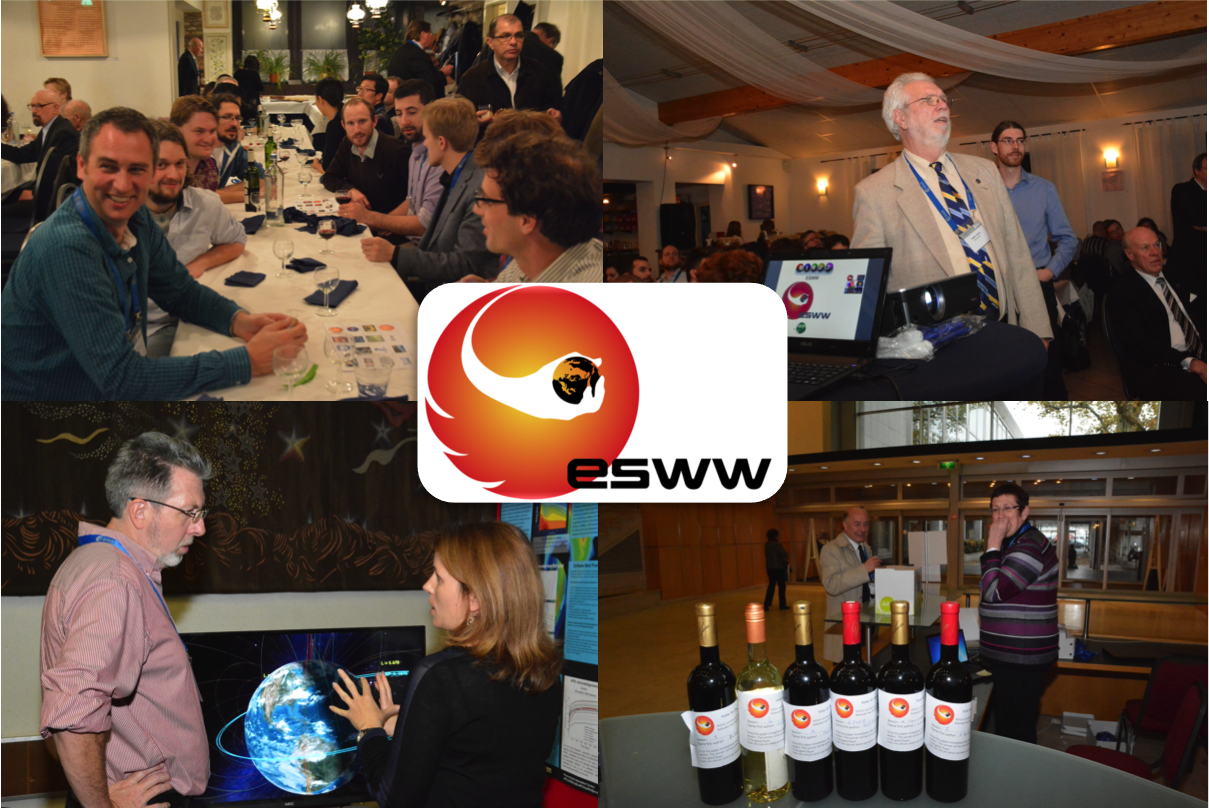
ESWW has always been one of the most photographed conferences ever. More photos on
http://www.stce.be/esww11/photo.php
If you are looking for solar, solar wind, and earth environment data at a glance and you want to see them on a timeline, even if you are not a computer expert: STAFF has it all.

STAFF is a dynamic online timeline viewer which allows you to plot and compare data with a few mouse clicks. The data includes x-ray, sunspots, radio measurements, proton and electron flux near Earth, solar wind and interplanetary magnetic field parameters, geomagnetic and ionospheric data, and readings from EUV solar images.
The nice thing is that you can increase the number of data points if you want higher time resolution. You can zoom in just like that. Or you can let the program choose the optimal sample interval for your desired timespan. You can make your science graphs even more exciting by picking your favourite colour!
Start your 2 dimensional cruise through the sun-earth system:
http://www.staff.oma.be/
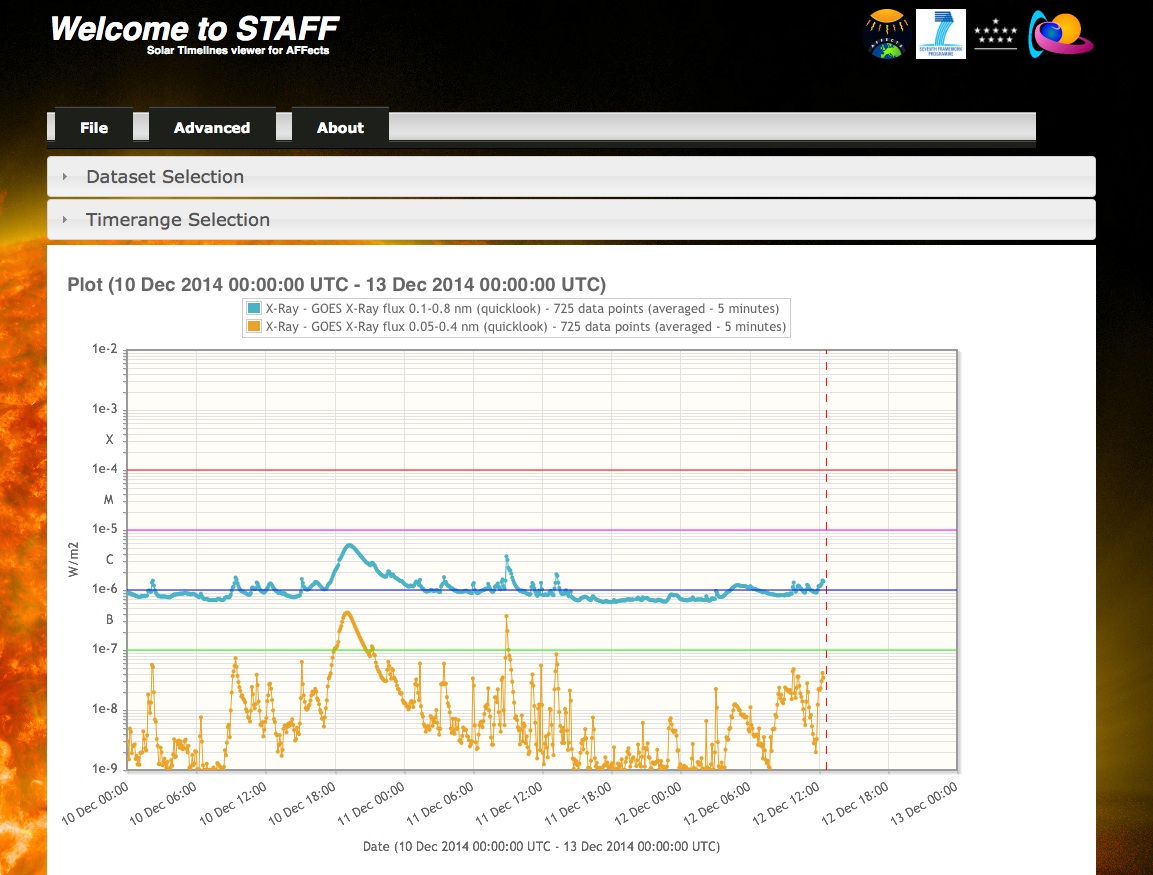
Solar flare activity fluctuated between low and moderate during the week.
In order to view the activity of this week in more detail, we suggest to go to the following website from which all the daily (normal and difference) movies can be accessed: http://proba2.oma.be/ssa
This page also lists the recorded flaring events.
A weekly overview movie can be found here (SWAP week 245).
http://proba2.sidc.be/swap/data/mpg/movies/weekly_movies/weekly_movie_2014_12_01.mp4
Details about some of this week’s events:
Below we provide SWAP images of the time when a strong M-flare occurred on Thursday. These annotated snapshots are produced by the Solar Feature Automated Search Tool (SoFAST). This tool detects dynamic solar events in EUV images from SWAP in real-time. More info on http://www.sidc.be/sofast.
M6.1 flare peaking around 18h25
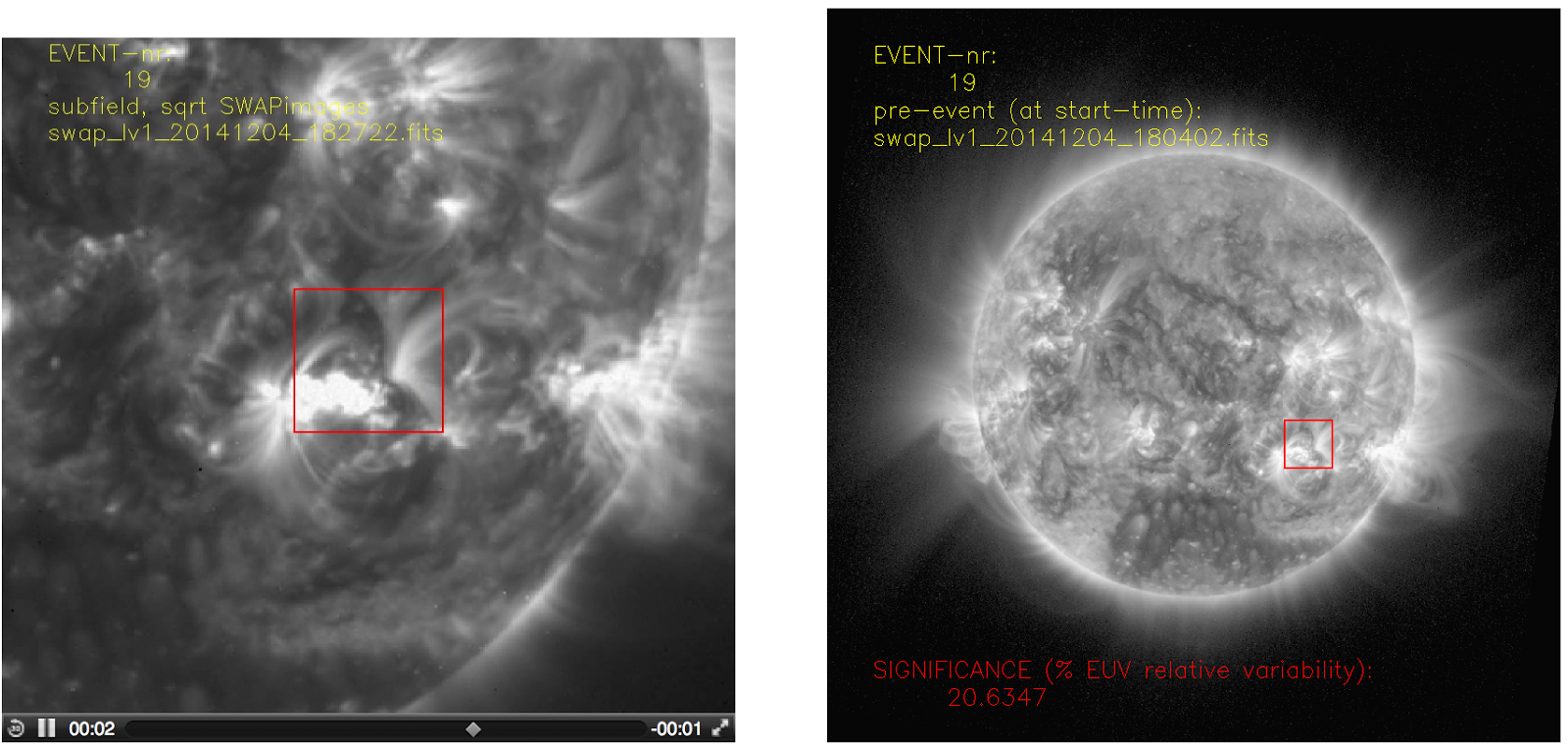
During last week, flaring activity was mostly at the C-class level (46 C-class flares reported), with addition of five confined M-class flares (no associated CMEs observed). An isolated M1.8 flare (peaking at 06:41UT) was reported on December 01. Three M-class flares (M1.3, M6.1, and M1.3) were reported on December 04 (peaking at 08:10, 18:25, and 19:41 UT, respectively). The last of the reported M-class during this week was the M1.5 flare on December 05 (peaking at 12:25UT). The M-class flares, as well as 32 C-class flares originated from the Catania sunspot group 24 (NOAA AR 2222), which kept beta-gamma configuration of its photospheric magnetic field during the whole week.
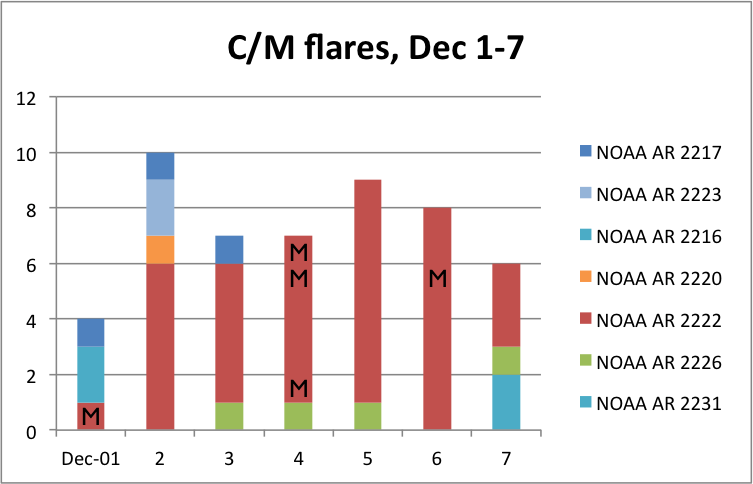
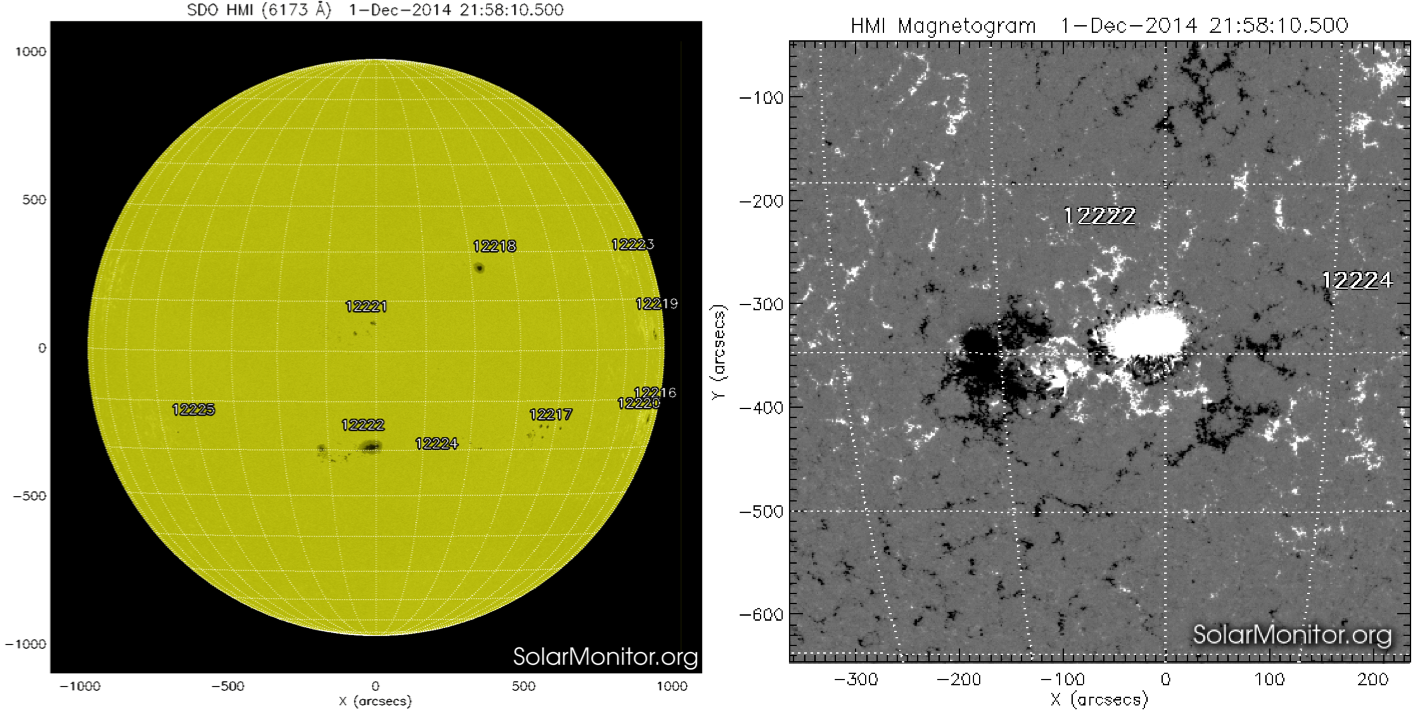
No wide, Earth-directed CMEs were observed this week.
| DAY | BEGIN | MAX | END | LOC | XRAY | OP | 10CM | TYPE | Cat | NOAA |
| 01 | 0626 | 0641 | 0659 | S21E17 | M1.8 | 1N | 24 | 2222 | ||
| 04 | 0800 | 0810 | 0821 | S24W27 | M1.3 | 1N | 24 | 2222 | ||
| 04 | 1805 | 1825 | 1856 | M6.1 | 24 | 2222 | ||||
| 04 | 1938 | 1941 | 1944 | M1.3 | 24 | 2222 | ||||
| 05 | 1133 | 1225 | 1247 | M1.5 | CTM/1 | 24 | 2222 |
| LOC: approximate heliographic location | TYPE: radio burst type |
| XRAY: X-ray flare class | Cat: Catania sunspot group number |
| OP: optical flare class | NOAA: NOAA active region number |
| 10CM: peak 10 cm radio flux |
The week started with the arrival of the fast solar wind, on the midday of December 01. The fast flow was associated with the extended low-latitude coronal hole (between N25 and N70) which reached central meridian on the morning of November 26 (transition of the coronal hole across the central meridian lasted more than two days). The solar wind speed increased to about 600 km/s (evening of December 01 and morning of December 02), and the interplanetary magnetic field magnitude was slightly enhanced amounting about 12 nT. The solar wind speed decrease to 400 km/s in the morning of December 03 and it was fluctuating around this value until December 06.
The fast solar wind originating from the large polar coronal hole with the extent to the low latitudes (up to about S40) arrived at the Earth on December 06. The interface between the slow and fast solar wind is a compression region where the density and the magnetic field strength have elevated values. The decrease of density and the strong increase of the solar wind speed and temperature (observed at about 16:00 UT on December 6), indicated the arrival of the fast flow itself. The maximum solar wind speed of about 820 km/s was observed on December 07. The highest value of the interplanetary magnetic field magnitude of about 25nT, was recorded at about 15:00 UT on December 6. The slow and fast speed, low and high temperature, compression region is indicated in the graph below. The solar wind parameters are measured by ACE at the L1 point.
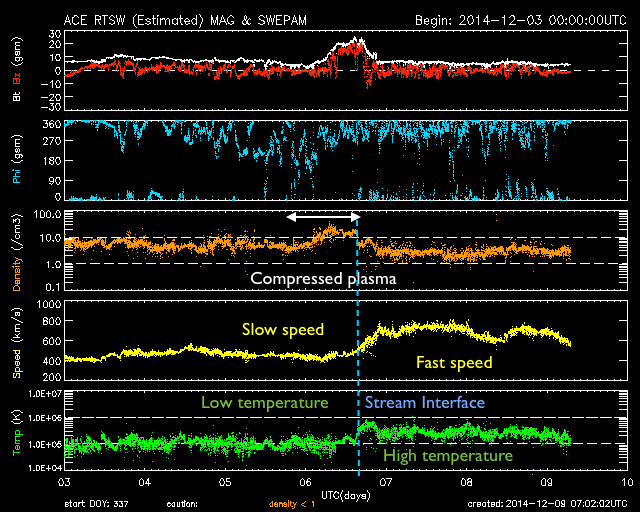
The arrival of the first high speed stream observed this week resulted in the unsettled to active geomagnetic conditions (K=4 was reported by IZMIRAN and Dourbes, and NOAA reported Kp=4) in the evening of December 01 and during December 02.
Due to arrival of the fast flow on December 06, few intervals of negative values of the Bz component of the interplanetary magnetic field (down to -14 nT at about 18:30 UT on December 6) were reported. This induced active to minor storm geomagnetic conditions lasting from about 18:00 UT on December 6 until midnight of December 07 (the local stations at Dourbes and Izmiran reported values of K=5, and NOAA reported two intervals of Kp=5).

The figure shows the time evolution of the Vertical Total Electron Content (VTEC) (in red) during the last week at three locations:
a) in the northern part of Europe(N61°, 5°E)
b) above Brussels(N50.5°, 4.5°E)
c) in the southern part of Europe(N36°, 5°E)
This figure also shows (in grey) the normal ionospheric behaviour expected based on the median VTEC from the 15 previous days.
The VTEC is expressed in TECu (with TECu=10^16 electrons per square meter) and is directly related to the signal propagation delay due to the ionosphere (in figure: delay on GPS L1 frequency).
The Sun's radiation ionizes the Earth's upper atmosphere, the ionosphere, located from about 60km to 1000km above the Earth's surface.The ionization process in the ionosphere produces ions and free electrons. These electrons perturb the propagation of the GNSS (Global Navigation Satellite System) signals by inducing a so-called ionospheric delay.
See http://stce.be/newsletter/GNSS_final.pdf for some more explanations ; for detailed information, see http://gnss.be/ionosphere_tutorial.php
Start : 2015-07-21 - End : 2015-07-23
The conference will review past and recent achievements, as well
as future challenges in the field of solar coronal loop
physics.
Website:
http://www.damtp.cam.ac.uk/user/astro/cl7/index.html
Start : 2015-07-30 - End : 2015-08-06
The 34th International Cosmic Ray Conference (ICRC) will be held
from July 30 to August 6, 2015, in The Hague, The Netherlands. It
is an important and large conference in the field of Astroparticle
Physics. The ICRC covers: cosmic-ray physics, solar and
heliospheric physics, gamma-ray astronomy, neutrino astronomy, and
dark matter physics.
Website: http://icrc2015.nl
Start : 2015-10-05 - End : 2015-10-09
This CSPM-2015 scientific meeting will cover various aspects of
solar dynamic and magnetic phenomena which are observed over the
entire electromagnetic spectrum: white-light, Hα, Ca II,
and radio from ground and in a variety of other wavelengths (white
light, UV and EUV, and X-rays) from space. Emphasis will also be
placed on instrumentation, observing techniques, and solar image
processing techniques, as well as theory and modelling through
detailed radiative transfer in increasingly realistic MHD models.
The long-term (cyclic) evolution of solar magnetism and its
consequence for the solar atmosphere, eruptive phenomena, solar
irradiation variations, and space weather, will be in focus. Here,
special attention will be devoted to the long-term observations
made in Coimbra and also to the results of the SPRING / SOLARNET
and SCOSTEP VarSITI studies. In particular, the weak solar activity
during the current solar maximum will be discussed. Finally, since
this meeting is organised around the 90th anniversary of performing
the first spectroheliographic observations in Coimbra, a session
will be specially dedicated to new solar instruments (both
ground-based and space-borne) that will give access to unexplored
solar atmospheric features and dynamic phenomena over the coming
years.
Website:
http://www.mat.uc.pt/~cspm2015/
Start : 2016-07-30 - End : 2016-08-07
The 41st COSPAR Scientific Assembly will be held in Istanbul,
Turkey from 30 July - 7 August 2016. This Assembly is open to all
bona fide scientists.
Website:
https://www.cospar-assembly.org/
Presentation, in French, given at the open doors of the Space Pole, Belgium, 2014
http://www.spaceweather.eu/en/repository/show?id=552
Lecture focusing on the effects of space weather, extreme space weather during SC24, and the space weather forecasting at the Space Pole (RWC Brussels). The lecture was given to the Public Observatory Beisbroek / COZMIX in Beisbroek, Brugge, Belgium. Solar amateur astronomers and public audience, in Dutch, about 35 attendees.
http://www.spaceweather.eu/en/repository/show?id=554
This presentation was given during the "ESWW11 – Forecaster Forum" splinter on 18 November 2014. It focuses on the forecast and evaluation of the flaring activity in sunspot group NOAA 2158 (September 2014). There were about 70 attendees (scientists).
http://www.spaceweather.eu/en/repository/show?id=555